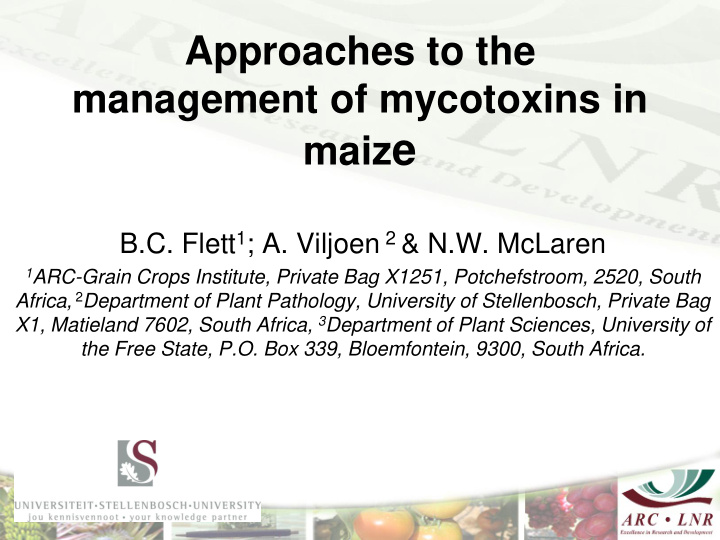



Approaches to the management of mycotoxins in maiz e B.C. Flett 1 ; A. Viljoen 2 & N.W. McLaren 1 ARC-Grain Crops Institute, Private Bag X1251, Potchefstroom, 2520, South Africa, 2 Department of Plant Pathology, University of Stellenbosch, Private Bag X1, Matieland 7602, South Africa, 3 Department of Plant Sciences, University of the Free State, P.O. Box 339, Bloemfontein, 9300, South Africa.
Introduction South Africa’s maize production and consumption (South African Department of Agriculture – Directorate Agricultural Statistics, 2009) Annual production: 9 .6 million tonnes Per capita consumption: 220 g per person per day
Introduction Processed for human consumption Processed for animal feed and other uses Export grain
What are mycotoxins? • Secondary metabolites produced by filamentous fungi in food crops that cause toxic response (mycotoxicosis) when ingested by animals and humans • Contaminate human food and animal feed through • Through fungal growth prior to and during harvest ( Fusarium spp., Diplodia and Aspergillus spp. ) • From improper storage ( Aspergillus spp. and Penicillium spp. )
Most important mycotoxins Mycotoxin Commodity Producing Mycotoxins group affected fungus AFB 1 , AFB 2 Aflatoxins Maize, Aspergillus flavus Aspergillus peanuts parasiticus Fusarium DON, NIV Trichothecenes Maize, wheat, graminearum barley ZEA Zearalenone Maize Fusarium graminearum FB 1 , FB 2 , FB 3 Fumonisins Maize Fusarium verticillioides Fusarium proliferatum
SYMPTOMS
Why are mycotoxins important? • Direct economic damage • Burden on US economy from aflatoxins, fumonisins and trichothecenes nearly US$ 1 billion annually • Mitigating losses another US$ 0.5 billion • Aflatoxin (1998): US$ 85-100 million in Texas, Louisiana and Mississippi • FHB of wheat and barley (1991-1997): US$ 2.6 billion in the USA
Why are mycotoxins important? • Affect the entire chain of food and feed production (producers (commercial and subsistence), food and feed manufacturers, and human and livestock feed) • Reduction of marketable grain, discounts for contaminated grain, increased cost of drying, decreased weight gain in animal feeding, fertility problems, and increased costs for animal health • Toxic to humans and animals • Restrict markets (for developing countries)
Disease triangle Total of conditions favouring susceptibility. HOST
Possible infection sites Kernel and silk infection via insect vectors Wind blown or splashed Stem damage by insects spores on silks or leaf or other means sheaths Leaf sheath infection Infection via seed or roots 1 I. Small
Ear rot disease cycles - monocyclic
Disease/mycotoxin management – pre harvest • Primary means of toxin production ( Fusarium spp., Diplodia spp.) • Potential control in production process • Cultural practices (minimise stress, tillage, crop rotation with non-hosts) • Optimal planting and harvest time • Insect control – Bt and insecticides • Biological control • Fungicides? • Resistance
Disease/mycotoxin management – post harvest • Legislation – legal allowable limits • Removal of damaged and rotted kernels: • Careful adjustment of the combine • Grading regulations • Grain cleaning • Secondary means of toxin production • Proper drying and storage • Heating and de-toxification not always effective
Recent international primary research focus areas • Taxonomy and population genetics • Genomics • Mycotoxin biosynthesis • Incidence and occurrence of mycotoxins • Biochemical and molecular detection techniques • Toxicology and risk assessment
Less researched international focus areas • Resistance: • Sources identified • Limited inclusion into breeding programs • Resistance in cultivars is poor • Disease epidemiology • Focus on specific factors affecting epidemiology • Complexities of interactions has been avoided • The complexities of ear rots and mycotoxins require a thorough understanding of interacting factors (understand entire disease triangle)
Needs for managing mycotoxins • Thorough understanding of the complex interactions in the disease/mycotoxin system • Identify intervention points in the disease/mycotoxin system • Take responsibility for mycotoxin problems in South Africa using local and international expertise • Legislation • Managing mycotoxins during the initial step in the chain i.e. production reduces risks further down the production chain
Research aims must endeavour to: • Be proactive by having affordable management strategies in place to empower farmers to control mycotoxins • Limit mycotoxins entering the storage, milling, manufacturing and consumption stages of the industry • Ensure food and feed safety and security for South African consumers • Limit mycotoxins for export markets where legislation is in place • Capacity building in South Africa
More recommend